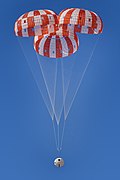Orion (spacecraft)
Orion, full name: Orion Multi-Purpose Crew Vehicle or Orion MPCV, is a spacecraft built by Lockheed Martin for NASA.
 An artist's picture of the Orion spacecraft | |
| Manufacturer | Lockheed Martin Airbus |
|---|---|
| Country of origin | United States of America |
| Operator | NASA |
| Applications | Beyond LEO exploration[1] |
| Specifications | |
| Spacecraft type | Space capsule |
| Design life | 21 days, 2 hours and 24 minutes[2] |
| Launch mass | Capsule: 10,387 kilograms (22,899 pounds) Service module: 15,461 kilograms (34,086 pounds) Total: 25,848 kilograms (56,985 pounds) |
| Crew capacity | 2–6[3] |
| Dimensions | 3.3 by 5 metres (11 by 16 feet) |
| Volume | Pressurized: 19.56 kilometres (12.15 miles)[4] Habitable: 8.95 m3 (316 cu ft) |
| Production | |
| Launched | 2 |
| First launch | December 5, 2014 |
| Related spacecraft | |
| Derived from | |
One of those flew into space (and back to Earth), as late as 2022's fourth quarter. That mission lasted 25 days. There were no astronauts on the flight.
A spaceflight with astronauts is planned for, no earlier than April 2026.
Each Orion spacecraft will be able to carry up to six[3] astronauts. The Orion vehicle will be launched on the Space Launch System.[5] The first launch (Exploration Flight Test-1) was on the Delta IV Heavy.[6]
History

Orion was first made for the Constellation program in 2004, as the Orion CEV (Orion Crew Exploration Vehicle). It was meant to be launched on the Ares I rocket. Then it would be able to go to the International Space Station. It was also planned to go to a spacecraft launched in pieces on different Ares V rockets, and the spacecraft with the Orion would go to the Moon, Mars, or another place.
In October, 2010, Constellation was cancelled. They created a new program and a new rocket called the Space Launch System, and changed the name of Orion to the Orion Multi-Purpose Crew Vehicle.[7]
Orion (spacecraft) Media
Orion Crew Module Model (Neil A. Armstrong Flight Research Center)
An artist's concept of an Orion spacecraft including the European Service Module with Interim Cryogenic Upper Stage attached at the back
Liftoff sequence of Orion on December 5, 2014
Related pages
References
- ↑ "NASA Authorization Act of 2010". Thomas.loc.gov. Archived from the original on December 19, 2010. Retrieved November 20, 2010.
- ↑ Bergin, Chris (July 10, 2012). NASA ESD set key Orion requirement based on Lunar missions. NASASpaceFlight.com. http://www.nasaspaceflight.com/2012/07/nasa-esd-key-orion-requirement-lunar-missions/. Retrieved July 23, 2012.
- ↑ 3.0 3.1 Moskowitz, Clara (November 2014). "Deep Space or Bust". Scientific American. 311 (6): 20. Bibcode:2014SciAm.311f..20M. doi:10.1038/scientificamerican1214-20.
- ↑ "Orion Quick facts" (PDF). NASA. August 4, 2014. Archived from the original (PDF) on June 3, 2016. Retrieved October 29, 2015.
- ↑ "Preliminary Report Regarding NASA's Space Launch System and Multi-Purpose Crew Vehicle" (PDF). NASA. January 2011. Retrieved June 18, 2011.
- ↑ Fountain, Henry (December 5, 2014). "NASA's Orion Spacecraft Splashes Down in Pacific After Test Flight". New York Times. https://www.nytimes.com/2014/12/06/science/nasa-orion-spacecraft-lifts-off-into-orbit.html. Retrieved December 5, 2014.
- ↑ "NASA Moon and Mars". nasa.gov. 25 June 2018. Archived from the original on 2021-04-07. Retrieved 2019-05-21.
Other websites
- Orion NASA webpage Archived 2011-05-27 at the Wayback Machine









